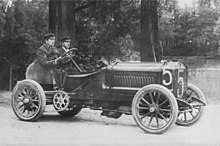
Certainly hot, June day 1906 Year, the modern history of motor racing began. For the first time, it was about winning the Grand Prize, where does the name of racing come from – Grand Prix - still a priority among all types of car racing. Already in the first races, the Grand Prix turned out, that the competitor's abilities and the upgrades used in the car will decide about the victory. In the case of the winning Renault, it was Louis Renault's chief mechanic – Ferenc Sis, and design news: thermosiphon cooling and replaceable wheel rims. While some riders wasted time breaking hot rubber from the rim, to be able to fit new tires, a trained Shish changed all four wheels over the course 3 min 47 s. Grand Prix ACF competition in 1907 years showed, how important it is to know the capabilities of your own vehicle, to which tactics should be adjusted. Shisha wasted precious ten minutes refueling, because he misjudged the fuel consumption in relation to the tank capacity; while Fiat was on the finish line 11 liters of fuel in the tank, Renault had three times as much, that is, enough to travel at least 100 km. After the Grand Prix races in 1908 year (ACF, USA) found, that increasing the power and speed of cars must go hand in hand with the simultaneous improvement of the chassis and change of other driving parameters, otherwise there is a risk of an accident. On the bad surfaces of the racetracks at the time and at speeds reaching up to 150 km / h broken axles, lost wheels or even "landing" cars” on the roof were no exception. In this way, the light Renaults had to succumb to the more stable one, sometimes even an overly dimensioned Mercedes, Fiat or Benz.
Despite the great sales of cars, achieved through advertising, that they did when they participated in the Grand Prix races, the costs of participating in competitions began to exceed the financial capabilities of many even powerful companies, so in years 1909-1911 there is no information about the organization of any event of this type. Only in 1912 During the year, a sufficient number of people interested in continuing the Grand Prix ACF competition applied. There is no Renault on the track anymore, instead, two new English cars appeared: Sunbeam i Vauxhall. Among the technical innovations, interchangeable wheels with a central nut and steel spokes should be mentioned, OHC valve timing and central spark plug ignition. OHC is a direct valve drive of internal combustion engines via a camshaft located in the cylinder head.
Grand Prix racing, preceding World War I, were held in great tension, Will the Mercedes cars prepared especially for this race win?, or the traditionally already Peugeot, being, as it were, "at home”. The victory of one of the two cars with almost the same power and speed was finally determined by a technical fault. Well, a few minutes before the finish line in a Peugeot engine, led by racing favorite Boillot, the valve broke. A winning Mercedes, having as one of the few rear wheel brakes, has survived to this day and is on display in the company's museum in Stuttgart.
World War I with all the misfortunes, which she was carrying with her, caused the intensification of the development of technology. Inventions and structures, used in the aviation industry were quickly adapted to automotive technology. V-shaped multi-cylinder engines, the use of light metals and alloys dates back to this period. The same multi-cylinder engines, as before, capacities allowed to reduce the size and weight of moving parts, hence increasing RPM and increasing power with the volume of the engine. The appearance of American cars in Europe also provided an opportunity to exchange experiences, so that soon hydraulic brakes and battery ignition ceased to be the domain of Duesenberg cars. In the 1920s, four-cylinder cars were already an exception among racing cars that had six, eight or twelve cylinders (Ballot i Delage). Year 1922 was a breakthrough year in organizing race car starts. The start of single cars used so far at regular intervals was changed at the Grand Prix ACF races in the French city of Strasbourg to simultaneous for all participants. The following year, the Italians indulged in another novelty. FIAT designers bypassed the regulations – keeping the statutory capacity, they applied a top-up (compressor – compressor), which increased the engine power. It wasn't really new anymore, because Louis Renault already in 1902 years patented a centrifugal compressor, and the American Chadwick practically applied it in 1907 year. However, most experience in supercharging engines was obtained during the war with the improvement of aircraft engines, and the Fiat concern also had planes in the production plans. Italian Grand Prix in Monza, recognized as the European Grand Prix, so she stayed at home thanks to Fiat cars”. Cars with two-liter supercharged engines developed power 95-130 kW (130—175 KM) and a maximum speed of approx 200 km/h. Formula of competition with 1925 r. she had excluded the mechanic from the car, thereby forcing the competitor to rely on his own strength, however, it was only after two years that the designers began to design one-seater cars, so-called. single-seater, and racing cars gradually began to change to more aerodynamic bodies.
The driving technique was also improved - the era of the so-called. controlled slip.